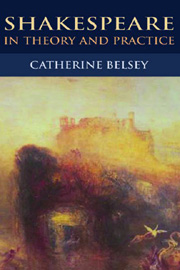Book contents
- Frontmatter
- Contents
- Preface
- 1 Introduction: Practising with Theory
- 2 Psychoanalysis and Early Modern Culture: Lacan with Augustine and Montaigne
- 3 Love as Trompe-l'oeil: Taxonomies of Desire in Venus and Adonis
- 4 Tarquin Dispossessed: Expropriation and Consent in The Rape of Lucrece
- 5 Antinomies of Desire and the Sonnets
- 6 Peter Quince's Ballad: Memory, Psychoanalysis, History and A Midsummer Night's Dream
- 7 The Illusion of Empire: Elizabethan Expansionism and Shakespeare's Second Tetralogy
- 8 Making Histories Then and Now: Shakespeare from Richard II to Henry V
- 9 The Case of Hamlet's Conscience
- 10 Iago the Essayist
- Notes
- Index
8 - Making Histories Then and Now: Shakespeare from Richard II to Henry V
Published online by Cambridge University Press: 12 September 2012
- Frontmatter
- Contents
- Preface
- 1 Introduction: Practising with Theory
- 2 Psychoanalysis and Early Modern Culture: Lacan with Augustine and Montaigne
- 3 Love as Trompe-l'oeil: Taxonomies of Desire in Venus and Adonis
- 4 Tarquin Dispossessed: Expropriation and Consent in The Rape of Lucrece
- 5 Antinomies of Desire and the Sonnets
- 6 Peter Quince's Ballad: Memory, Psychoanalysis, History and A Midsummer Night's Dream
- 7 The Illusion of Empire: Elizabethan Expansionism and Shakespeare's Second Tetralogy
- 8 Making Histories Then and Now: Shakespeare from Richard II to Henry V
- 9 The Case of Hamlet's Conscience
- 10 Iago the Essayist
- Notes
- Index
Summary
Shakespeare's history plays are not commonly taken seriously as history. Everyone knows that they are not accurate. Much of the material is pure invention, so the argument goes, and even when it is not, both story and characterisation are seen to have been significantly modified in the interests of vital and enduring drama, on the one hand, and the glorification of the Tudor dynasty on the other. Brilliant fictions, and perhaps equally brilliant propaganda, the history plays are understood to be precisely art, not life, imagination and not truth.
Is it possible that this account reveals as much about the literary institution and the distinctions it takes for granted as it does about Shakespeare's texts? History, it assumes, enables us to measure the accuracy of the plays and find them wanting – as truth. At the same time, and paradoxically, imagination throws into relief the dullness of mere empirical fact: art is regarded as dazzling where history is drab. In either case, the term ‘history play’ is something of an oxymoron. History, real history, conventionally stands outside literature as its binary opposite, fact as opposed to fiction.
Or it did. Our postmodern condition has called into question that antithesis, and perhaps in the process identified ‘history plays’ as a more sympathetic category for us now. I want, not purely perversely, to read Shakespeare's second tetralogy as history.
- Type
- Chapter
- Information
- Shakespeare in Theory and Practice , pp. 119 - 138Publisher: Edinburgh University PressPrint publication year: 2008

